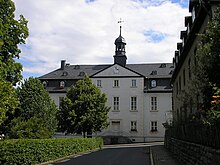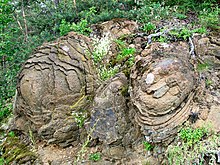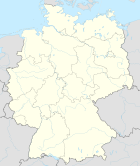Saalburg-Ebersdorf
| coat of arms | Germany map | |
|---|---|---|

|
Coordinates: 50 ° 30 ' N , 11 ° 42' E |
|
| Basic data | ||
| State : | Thuringia | |
| County : | Saale-Orla district | |
| Height : | 431 m above sea level NHN | |
| Area : | 72.05 km 2 | |
| Residents: | 3359 (Dec. 31, 2019) | |
| Population density : | 47 inhabitants per km 2 | |
| Postal code : | 07929 | |
| Primaries : | 036647, 036651 | |
| License plate : | SOK, LBS, PN, SCZ | |
| Community key : | 16 0 75 135 | |
City administration address : |
Parkstrasse 1 07929 Saalburg-Ebersdorf |
|
| Website : | ||
| Mayor : | Volker Ortwig ( FDP ) | |
| Location of the city of Saalburg-Ebersdorf in the Saale-Orla district | ||


Saalburg-Ebersdorf is a town in the Saale-Orla district in Thuringia , which is located on the Bleiloch reservoir, the largest reservoir in Germany .
The city was created on January 1, 2003 through the legal merger of the city of Saalburg and the municipality of Ebersdorf / Thuringia . The urban area is 7,189.01 hectares ; the population is around 3700.
geography
Saalburg-Ebersdorf is located on the Bleilochtalsperre , the reservoir with the largest capacity in Germany.
The Totenfels near Sopoten drops steeply to the surface of the reservoir. Before the damming of the Saale, it flowed right under the Totenfels. People are said to have fallen down here. Therefore, the site is considered to be a former cult site.
Neighboring communities
Neighboring communities are (clockwise) Schleiz , Tanna , Bad Lobenstein and Remptendorf .
City structure
(in brackets the date of the first documentary mention)
The municipality includes the parts of the municipality Ebersdorf (December 14, 1401), Friesau (1344), Kloster , Kulm (1223), Pöritzsch (April 15, 1352), Raila (August 14, 1325), Röppisch (November 12, 1322), Saalburg (1216), Schönbrunn (August 14, 1325), Wernsdorf (December 14, 1401) and Sopoten (August 14, 1325).
history
The incorporated city of Saalburg was first mentioned as a place in 1216 and as a city in 1313. To control the Saale crossing of the old trade route from Nuremberg to Leipzig, the Lobdeburgers built a castle in Saalburg in 1216. This date is also the first mention of Saalburg. In 1317 it came into possession of the bailiffs of Gera . The castle was located on the right bank of the Saale, on what would later be the place of the castle. (The keep collapsed in 1913, remains of which are still preserved today.)
The city of Saalburg probably goes back to the establishment of the Landgraves of Thuringia , had been independent since 1222 and had a close historical connection to the former Principality of Reuss . In 1930 the electrified Schleiz – Saalburg railway was opened by Schleizer Kleinbahn AG. However, for economic reasons, operations were discontinued after 1995.
Between 1647 and 1666, Saalburg was the capital of the Reuss-Saalburg county . Ebersdorf was the residence of the Principality of Reuss-Ebersdorf from 1678 to 1848 . The pietist-minded princes of the Reuss line had the Moravian Brethren settle in Ebersdorf in the 18th century .
On October 8, 1806, the first battle of a war between Napoleon's troops and Prussia took place on the banks of the Saale . Both sides recorded their first casualties, each about 10 to 15 wounded and killed soldiers. The next day Napoleon stayed at Ebersdorf Castle. A picture by Benjamin Zix that is in the Louvre's holdings captured this situation.
The businessman Christian Heidecke (from Berlin ) and the building contractor Magnus Rödel (from Birkenhügel ) founded the Saalburg marble factory Rödel & Co. in 1888 , which initially started operations in the Herrenmühle on the Saale above the town. Around 1900 the company employed an average of 100 people in the areas of sawmill , grinding and sculpture . This made the company one of the largest marble factories in Germany at this time. The plant expanded its attractive range by opening new quarries and purchasing existing quarrying sites in the limestone deposits of the region. In addition to native stones , foreign marble types, primarily of Italian origin, were also processed here. The plant survived the First World War with great difficulty and in 1919 received the order to manufacture the sarcophagus for Duchess Victoria Feodora of Mecklenburg (Princess Viktoria Feodora Reuss jL † December 18, 1918), which was installed in the Doberan Minster . In 1925 the company had 116 employees. With the construction of the Bleilochtalsperre (between 1926 and 1932) the company was due to be closed due to the inevitable flooding of its area. In 1931 the operating facilities were torn down. This led to an emigration of staff and the merger with a regional competitor. With the help of public subsidies, the new company was moved to the outskirts of Saalburg and production was resumed here on January 2, 1932.
A new company owner, who was an active member of the NSDAP and had good connections to the system, practiced political harmonization quite openly in company life after the National Socialist seizure of power . This demonstrative positioning earned him extensive orders from official NS agencies after 1933.
During the Second World War , 20-30 workers from the occupied countries had to do forced labor in the Kurt Horn sawmill in the Friesau district and with farmers in the Friesau, Röppisch , Schönbrunn and Sopoten districts . Twelve concentration camp prisoners from a death march from Buchenwald to Flossenbürg concentration camp , who were murdered by SS men , rest in the cemetery in Ebersdorf . Memorial stones erected in 1985 on the village squares of Ebersdorf and Sopoten also commemorate this event. Memorial stones on the beach promenade in Saalburg commemorate the murder of 64 concentration camp prisoners on April 12, 1945.
In 1946, the marble factory was expropriated by order of SMAD and incorporated into the property of the State of Thuringia . The first major order after 1945 was the elaborate furnishing of the Soviet embassy in Berlin. Further orders followed in the city center. Particularly noteworthy is the interior design of the Berlin State Opera from 1953, which required the highest level of marble processing skills. Greek, French, Italian, German marbles , limestone and serpentinite were used for the floor inlay of the Apollo Hall . Many of these orders illustrate the technical and planning skills that have developed among the marble works' workforce since it was founded, which mainly consisted of residents of Saalburg and the surrounding area.
At the Bleilochtalsperre, the central school of Ebersdorf ran a summer camp during GDR times .
Before the legal merger of the city of Saalburg and the municipality of Ebersdorf / Thuringia on January 1, 2003, the city of Saalburg belonged to the Saalburg administrative community .
Incorporations
The unified municipality of Ebersdorf / Thuringia was created on May 6, 1993 through the voluntary merger of the previously independent municipalities of Ebersdorf, Friesau, Röppisch, Schönbrunn and Sopoten with about 2900 inhabitants. The administrative seat was in Ebersdorf.
Pöritzsch was incorporated into the city of Saalburg on July 1, 1950. Kulm and Wernsdorf followed on January 1, 1974. Finally, Raila was added on March 8, 1994.
Population development
Development of the population (December 31st) of
the city of Saalburg before 2003:
|
|
|
of the Ebersdorf community before 2003:
|
|
|
of the city of Saalburg-Ebersdorf:
|
|
|
Data source from 1994: Thuringian State Office for Statistics
politics
City council
The local elections on May 26, 2019 resulted in the following distribution of seats for the 2019-2024 legislative period :
| Party / list | Seats |
| CDU | 9 (−1) |
| SPD | 4 (+1) |
| FDP | 3 (± 0) |
coat of arms
Until a new city coat of arms is decided by the city council, the two coats of arms of the formerly independent places Ebersdorf and Saalburg remain valid.
Saalburg coat of arms
Blazon : “Half split and divided; in the raised upper fields in front a golden lion in red, behind in blue on a green mountain a pointed silver round tower, below in blue on silver waves a black boat. "
The coat of arms of Saalburg goes back to the oldest known seal from 1387. In its current representation, the coat of arms was officially used for the first time in 1942. The lion is the chateau. The keep belonged to the castle which collapsed in 1913. The illustration in the lower field indicates the location of the city on the Saale and was created after the traffic jam around 1935/36; in the previous seal picture there was a man in a boat.
Coat of arms of Ebersdorf
Blazon : “Square of black and silver; 1 and 4: a raised golden crowned golden lion with a knocked out red tongue; 2 and 3: a golden walking crane. "
tourism
The Eisenach – Budapest mountain hiking trail and the Saale cycle path run through Saalburg .
Once a year, the SonneMondSterne -Festival takes place near the city .
Personalities
sons and daughters of the town
- Zacharias Liebhold von Solbergk (1552–1626), town clerk of Silberberg in Silesia and theater poet
- Benigna Marie Reuss zu Ebersdorf (1695–1751), Countess Reuss von Lobenstein, hymn poet
- Heinrich XXIX. Reuss zu Ebersdorf (1699–1747 in Herrnhaag), was Count Reuss zu Ebersdorf
- Erdmuthe Dorothea von Zinzendorf , b. Reuss zu Ebersdorf (1700–1756), pietist and hymn poet
- Heinrich XXIV. Reuss zu Ebersdorf (1724–1779), Count Reuss zu Ebersdorf
- Auguste Reuss zu Ebersdorf (1757–1831), Duchess of Saxe-Coburg-Saalfeld
- Heinrich LI. Reuss zu Ebersdorf (1761–1822), Prince Reuss zu Ebersdorf
- Heinrich LXXII. Reuss zu Lobenstein and Ebersdorf (1797–1853), Prince Reuss zu Ebersdorf and Prince Reuss zu Lobenstein and Ebersdorf
- Albert von Seckendorff (1849–1921), Vice Admiral of the Imperial German Navy, diplomat , court marshal of Prince Heinrich of Prussia
- Heinrich XLV. Prince Reuss younger line (1895 – presumably 1945), Reussian prince
- Axel Teichmann (* 1979), cross-country skier (world champion and world cup winner)
- Charles Franzke (* 1992), biathlete and extreme obstacle runner
Other personalities
- Hermann I von Lobdeburg (unknown – 1254), 1225–1254 Bishop of Würzburg, 1216–1225 co-regent in the Saalburg line of the House of Lobdeburg
- Joachim Murat (1767–1815), fought in the Fourth Coalition War on October 8, 1806, to cross the Saale near Saalburg
- Lola Montez (1821–1861), Irish dancer and a lover of King Ludwig I of Bavaria, guest at Ebersdorf Palace in 1843
- Meta Wellmer (1826 (according to other information 1832) –1889), writer and educator at the Brethren Congregation for 18 years
- Christian Heidecke (1837–1925), architect, co-founder of the Saalburg marble works
- Bodo Ramelow (* 1956) has had a secondary residence in the Saalburg district since 2016
traffic
The station Ebersdorf-Friesau located on the triptis-marxgrün railway . There is only freight traffic . The Saalburg (Saale) train station was on the now disused Schleiz – Saalburg railway .
With the lines 610, 620 and 730 of the KomBus transport company , Saalburg-Ebersdorf has connections to the cities of Schleiz , Bad Lobenstein , Lehesten , Naila , Ziegenrück and Tanna .
Web links
Individual evidence
- ^ Population of the municipalities from the Thuringian State Office for Statistics ( help on this ).
- ^ StBA: Changes in the municipalities in Germany, see 2003
- ↑ Michael Köhler: Pagan sanctuaries. Pre-Christian places of worship and suspected cult sites in Thuringia. Jenzig-Verlag Köhler, Jena 2007, ISBN 978-3-910141-85-8 , p. 245.
- ^ Wolfgang Kahl : First mention of Thuringian towns and villages. A manual. 5th, improved and considerably enlarged edition. Rockstuhl, Bad Langensalza 2010, ISBN 978-3-86777-202-0 , pp. 63, 81, 155, 222, 226, 238, 243, 255, 311, 326.
- ^ Wolfgang Kahl: First mention of Thuringian cities and villages up to 1300. A manual. 2nd, improved edition. Rockstuhl, Bad-Langensalza 2001, ISBN 3-934748-58-9 , p. 53.
- ^ Werner Mägdefrau : Thuringian cities and city federations in the Middle Ages. Rockstuhl, Bad- Langensalza 2002, ISBN 3-936030-34-0 , p. 66.
- ↑ Michael Köhler: Thuringian castles and fortified prehistoric and early historical living spaces. Jenzig-Verlag Köhler, Jena 2001, ISBN 3-910141-43-9 , p. 216.
- ↑ Thomas Bienert: Medieval castles in Thuringia. 430 castles, castle ruins and fortifications. Wartberg-Verlag, Gudensberg-Gleichen 2000, ISBN 3-86134-631-1 , p. 221.
- ↑ Werner Mägdefrau: Thuringia in the High Middle Ages (= writings of the Wartburg Foundation Eisenach. 6, ZDB -ID 32783-9 ). Wartburg Foundation, Eisenach 1989, pp. 88–89.
- ↑ www.monneuse.de
- ↑ a b Otmar Hartenstein, Peter Lange, Elsa Schneider: Saalburg marble - a mineral treasure of East Thuringia. Saalburger Marmorwerke GmbH, Saalburg undated (approx. 1990).
- ↑ Thuringian Association of the Persecuted of the Nazi Regime - Association of Antifascists and Study Group of German Resistance 1933–1945 (Ed.): Local history guide to sites of resistance and persecution 1933–1945. Volume 8: Thuringia. VAS - Verlag für Akademische Schriften, Frankfurt am Main 2003, ISBN 3-88864-343-0 , p. 221.
- ↑ a b Federal Statistical Office: Municipalities 1994 and their changes since 01.01.1948 in the new federal states. Metzler-Poeschel, Stuttgart 1995, ISBN 3-8246-0321-7 .
- ^ Thuringian State Office for Statistics, 2014 municipal council elections in Thuringia - final result for Saalburg-Ebersdorf
- ^ Thuringian State Office for Statistics, municipal council election 2019 in Thuringia - final result for Saalburg-Ebersdorf
- ↑ Hartmut Ulle: New Thuringian Wappenbuch. Volume 2: Ilmkreis, Jena, Kyffhäuserkreis, Saale-Orla-Kreis, Saalfeld-Rudolstadt (district), Schmalkalden-Meiningen (district), Suhl. 2nd, changed, revised edition. Working group Genealogy Thuringia, Erfurt 1997, ISBN 3-9804487-2-X , p. 43.
- ↑ www.thueringer-naturbrief.de
- ↑ Peter Hagen: Celebrity growth in Saalburg: Prime Minister Ramelow has acquired bungalow. April 21, 2016, accessed on February 13, 2020 (German).








